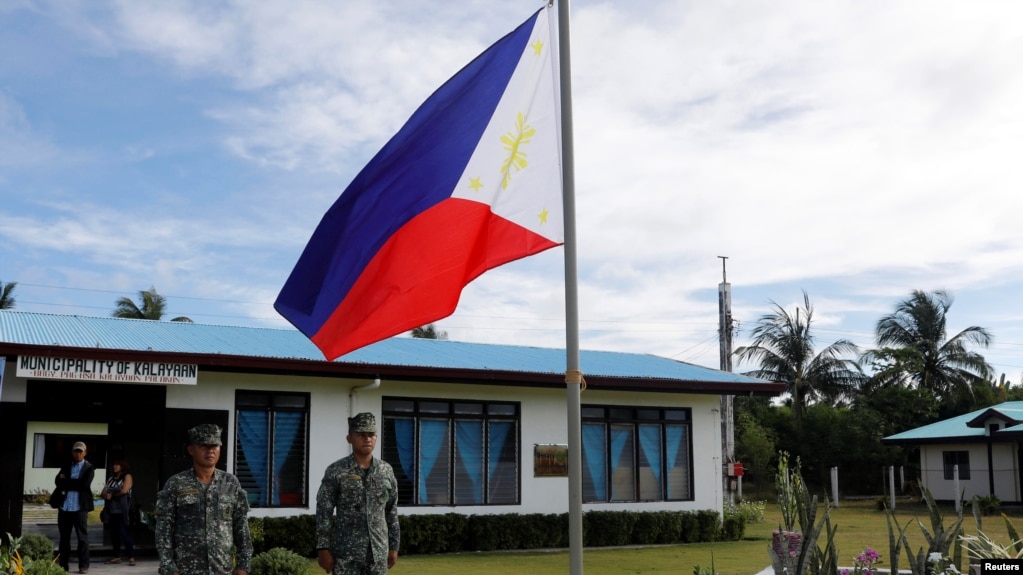
FILE - Filipino soldiers stand at attention near a Philippine flag at Thitu island in disputed South China Sea, April 21, 2017
China and the Philippines became friends in 2016 after four years of struggling for control over a shoal where both sides fish. The friendship has held, but in December and January, China moved as many as 90 ships close to another islet they dispute to monitor Philippine construction of a beaching ramp.
The naval, coast guard and idle fishing vessels just watched, but Philippine officials know China has the more powerful military. Still, the Philippines is expected to keep building on the islet, called Thitu, without hurting relations with China.
"It will continue, but there seems to be no effort on the part of the Philippine government to try to at least say something or file a diplomatic protest regarding the number of boats that have responded to the development," said Maria Ela Atienza, a University of the Philippines political science professor.
China values its friendship with the Philippines to keep Manila's ally, Washington, out of the maritime dispute, scholars believe, so it moved ships near Thitu in a way that raises alarm without stopping island construction or causing other material setbacks.

Authority in the Spratly Islands
The 37-hectares (90 acres) belongs to a bigger sovereignty dispute over the South China Sea where it's located.
China claims about 90 percent of the 3.5 million-square-kilometer waterway, competing for sovereignty with five other governments, including the Philippines. Beijing has taken a lead militarily over the past decade to access the sea's fisheries, oil and gas.
Scarborough Shoal, over which the two countries sparred from 2012 to 2016 before making amends, is in the same sea.
On Thitu, one of nine Philippine-held islands in the sea's Spratly chain, the beaching ramp should be finished in early 2019, the Philippine defense secretary, Delfin Lorenzana, has said.
Resident housing, a fishing port, desalination plant, solar energy project and marine research facilities are eventually due on the islet with a population of about 100 people, the Asia Maritime Transparency Initiative, under the Center for Strategic & International Studies, a U.S. research group, said.
Chinese ships ranging from 30 to 70 meters in length arrived in December and January from Subi Reef, a Chinese-controlled feature about 22 kilometers (14 miles) away, the initiative said.

FILE - Philippine troops march as a Philippine Air Force C-130 transport plane carrying Philippine Defense Secretary Delfin Lorenzana, Armed Forces Chief Gen. Eduardo Ano and other officials, sits on the tarmac at the Philippine-claimed Thitu Island.
Still friends, still building
The Philippine defense secretary said earlier this month construction will continue on Thitu Island. An official in the armed forces called the ships "no cause for worry," according to a Feb. 14 report by the domestic news website Inquirer.net. Manila did not formally protest to Beijing over the ship movement.
These reactions by Philippines officials will keep alive the friendship that President Rodrigo Duterte arranged in mid-2016, effectively letting island construction continue without incident, experts believe.
"I don't expect this to have a major impact on Sino-Philippine relations as long as the Chinese can refrain from violence, but it is a reminder of why the armed forces and defense bureaucracy in the Philippines have been unwilling to fully buy into Duterte's embrace of Beijing," maritime initiative director Gregory Poling said.
The lack of violence may even be remembered as a concession from China, said Alan Chong, associate professor at the S. Rajaratnam School of International Studies in Singapore.
"It's probably a nicely shrouded provocation to the Philippines, but it cannot be drummed up any further, because there will be voices that point out it's a concession," Chong said. "China will continue its provocations. The fact that they haven't sent warships and aircraft means their provocations are reduced to a nonconfrontational level."

FILE - The Vietnamese-claimed Southwest Cay island in the Spratly island group is seen from a Philippine Air Force C-130 transport plane during the visit to the Philippine-claimed Thitu Island by Defense Secretary Delfin Lorenzana, Armed Forces Chief Gen.
More ship movement
China has sent its "militia" to "intimidate and harass" other maritime claimants before, Poling said. Hundreds of idle, pro-government Chinese fishing vessels operate near Subi Reef, he added.
Beijing and Manila have grown used to "cat-and-mouse" games in the Spratly Islands, said Oh Ei Sun, senior fellow with the Singapore Institute of International Affairs. Last year, someone from China planted the Chinese flag on a Sandy Cay, a Spratly feature normally under Philippine control.
Brunei, Malaysia, Taiwan and Vietnam also claim all or parts of the South China Sea. Another Chinese "paramilitary force" about the size of the one that visited Thitu Island backed up a Chinese oil firm that had parked a rig in waters contested by Vietnam in 2014, Poling said.
China will probably send more fleets near islands controlled by other countries once it buries a year-old trade dispute with the United States, which believes China should keep the sea open internationally, Oh said.
"I don't see China having major movements in the South China Sea over the next few — let's say months or so — and that's because they are focusing on these trade negotiations, and they would not like to get distracted. But after the trade negotiations are settled, we might see some major movements of China in the region," he said.

No comments:
Post a Comment
Note: Only a member of this blog may post a comment.